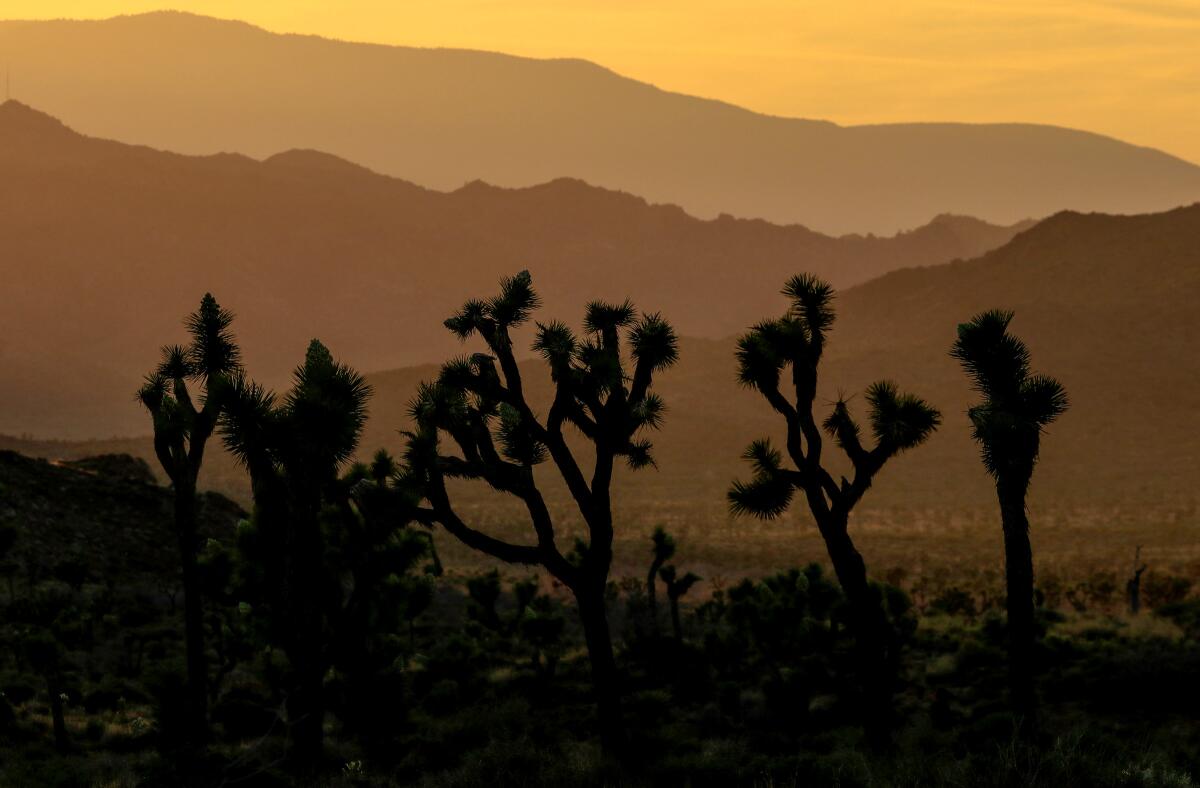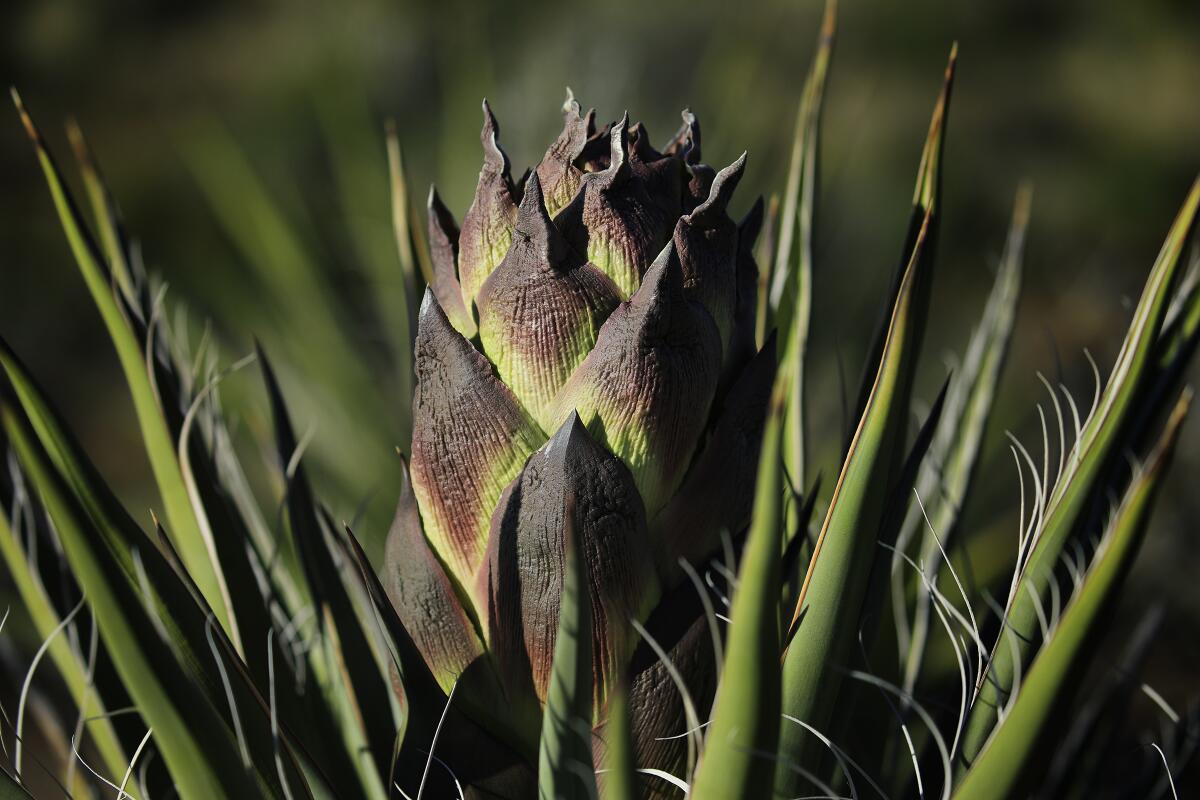Joshua trees are California icons. Should they also be designated threatened species?

Brendan Cummings doesn’t need to go far to find a dying signature of Southern California’s desert landscape: He stands on his porch and eyes whole forests of Joshua trees that haven’t produced seedlings in decades.
Interspersed among the trees are exotic grasses that feed off nitrogen-laden smog wafting in from the Los Angeles area. They have left the spindly woodlands in the hills north of Joshua Tree National Park vulnerable to brush fires spurred by a whiplash of wetter winters and drier summers, due to climate change.
“If we don’t take action soon, the only places we’ll still have Joshua trees to ooh and aah over will be botanical gardens and old Instagram accounts,” said Cummings, who lives near Yucca Valley and is conservation director for the Center for Biological Diversity, a conservation group.
The center hopes to spur that action with a petition it filed Tuesday with the California Fish and Game Commission, seeking that it list the western Joshua tree as threatened under the state Endangered Species Act. If that designation were approved, it could end up curbing development on thousands of acres of private desert property.
The petition argues that populations of the species, known as Yucca brevifolia, are “likely to become endangered in the foreseeable future” without special protection and better management.
State wildlife authorities declined to comment, pending a review of the petition.
The western Joshua tree is one of two genetically distinct species that occur in California. It has a boomerang-shaped range that extends from Joshua Tree National Park westward along the northern slopes of the San Bernardino and San Gabriel Mountains; northward along the eastern flanks of the Sierra Nevada and eastward to the edges of Death Valley National Park.
The area includes the cities of Palmdale, Lancaster, Hesperia, Victorville, Yucca Valley and the 800,000-acre national park, where an estimated 2.5 million Joshua trees will lose upward of 90% of their current range if warmer, drier conditions continue in the coming decades.
The eastern Joshua Tree’s range in California is centered in the Mojave National Preserve and eastward into Nevada.
While both the western and eastern species of Joshua tree face an uncertain future, the fate of the western species is of special concern to conservationists. That’s because recent studies show its range is contracting at lower elevations, and its reproduction has all but come to halt.
Joshua trees were once dispersed across landscapes with help from elephant-sized giant ground sloths, a finding based on the abundance of seeds found in fossilized dung. But these sloths went extinct about 10,000 years ago, taking away the tree’s Johnny Appleseed. Today, rodents are their main agents of distribution.
While western Joshua trees are not at imminent risk of extinction, they face significant and growing threats, primarily from climate change and urban sprawl, according to the petition.
Many desert species rely on the trees’ blossoms, roots, inner chambers and decaying husks to fulfill their life cycles: yucca moths, skipper butterflies, termites, ants, desert night lizards, kangaroo rats, woodrats and 20 species of birds, including Scott’s orioles, ladder-backed woodpeckers and great horned owls.
More is at stake than their relationship with the surrounding desert landscape. Joshua trees are cultural mainstays for movies, fashion shoots, advertising campaigns and wedding ceremonies. One of them adorned the cover of U2’s 1987 album “The Joshua Tree.”
The trees were named for the biblical figure Joshua by a band of Mormons traveling through the Cajon Pass back to Utah in 1857, who imagined them as prophets, their outstretched limbs pointing the way to their promised land.
Researchers for decades have been sounding the alarm about threats to the trees that grow about 40 feet in height and live about 200 years.
Since the 1980s, hundreds of thousands of Joshua trees have been removed to make way for renewable energy facilities or replaced by housing tracts and shopping centers in desert boom towns such as Lancaster and Palmdale.
In the 1990s, moist El Niño conditions triggered explosive growth of invasive grasses prone to brush fires such as one that charred 14,000 acres in 1999.

“Climate change represents the single greatest threat to the continued existence of Yucca brevifolia,” the petition says. “Under warming scenarios consistent with current domestic and global trajectories, the species will likely be close to being functionally extinct in the wild in California by century’s end.”
The globe’s average temperature is expected to rise roughly 5 degrees to 7 degrees Fahrenheit by the end of the century, scientists say. Computer models depicting the distribution of suitable habitat after a roughly 5-degree Fahrenheit rise show Joshua trees retaining just 2% to 10% of their current range in the national park, according to studies led by UC Riverside ecologist Cameron Barrows.
Joshua trees already seem to be dying back, scientists say, with recruitment of new seedlings all but stopped at the drier, lower limits of their range. Prolonged droughts, which are expected to occur with greater frequency and intensity over the coming decades, will lead to higher death rates for mature trees.
As part of an effort to reverse the grim trend, the conservation group WildEarth Guardians in 2015 petitioned the U.S. Fish and Wildlife Service to list Joshua trees throughout the Southwest as threatened under the federal Endangered Species Act.
In a response earlier this year, the service found that listing Joshua trees as a federally endangered species was not warranted. That’s because the agency’s own analyses downplayed the threats of climate change and highlighted their resilience.
Cummings ripped into the agency’s finding.
“Under the California Endangered Species Act,” he said, “when determining whether a species is threatened or endangered under state law, the term ‘range’ refers to where it is found in California, not across the nation or worldwide.
“Given the failures of the federal government on climate change generally — and the Joshua tree specifically,” he added, “action by California remains the best hope of saving this iconic species from extinction.”







